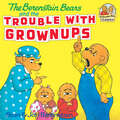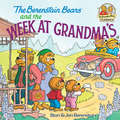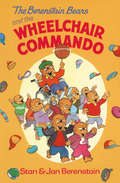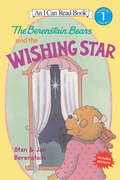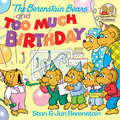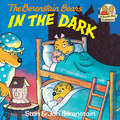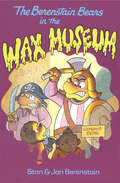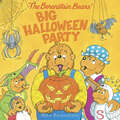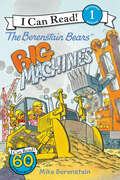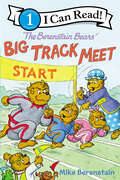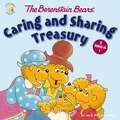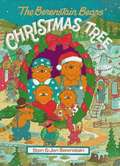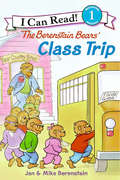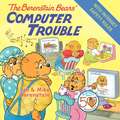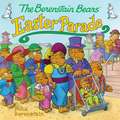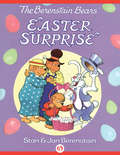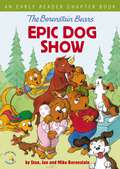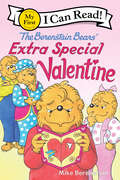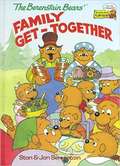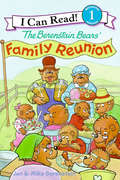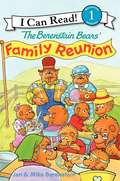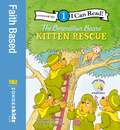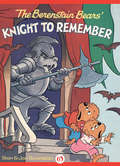- Table View
- List View
The Berenstain Bears and the Trouble with Grownups (First Time Books(R))
by Stan BerenstainBrother and Sister Bear's parents always seem to be nagging them about something, so the cubs decide to show how their parents annoy them by creating a play entitled "The Trouble with Grownups." Then Mama and Papa put on their own role-reversal skit, and everyone winds up learning something about themselves.
The Berenstain Bears and the Week at Grandma's (Berenstain First Time Chapter Books)
by Stan Berenstain Jan BerenstainBrother and Sister worry about spending a week at Gran and Gramp's house. By the end of the visit they've learned a lot from their lively grandparents--and the older bears have discovered how wonderful it is to be grandparents.
The Berenstain Bears and the Wheelchair Commando
by Stan Berenstain Jan BerenstainHarry McGill teaches Too-Tall a lesson about respect Harry McGill is new to Bear Country School, and he's off to a rough start with the other cubs because he's in a wheelchair. He's a whiz at the computer and chess, but has a hard time making friends--especially because Too-Tall is making fun of him and calling him "Wheels." Can Harry teach Too-Tall a lesson by playing him in a game of basketball?
The Berenstain Bears and the Wishing Star (I Can Read Level 1)
by Stan Berenstain Jan BerenstainSister Bear is thrilled by the magic of the wishing star, but Brother Bear teaches her that hard work is important too.
The Berenstain Bears and too Much Birthday (First Time Books(R))
by Stan Berenstain Jan BerenstainIs there such a thing as too much birthday? Poor Sister is overwhelmed by her big, noisy sixth-birthday party. Her sympathetic parents help her realize the true importance of having a birthday in this humorous exercise in moderation for cubs--and parents.
The Berenstain Bears are a Family
by Stan Berenstain Jan BerenstainThe Bear family meets their uncle, aunt, cousin and grandparents for a picnic and a lot of fun in this cute book. The story is told in rhyme. Other books about the Berenstain Bears are available from Bookshare. This book contains picture descriptions.
The Berenstain Bears in the Dark (I Can Read!)
by Stan Berenstain Jan BerenstainAfter a scary bedtime story, Sister Bear is too frightened of the dark to shut her eyes. "Sound psychological advice and a night light help Sister conquer her fears. Children will empathize with Sister Bear in this well-written story. "--School Library Journal.
The Berenstain Bears in the Wax Museum
by Stan Berenstain Jan BerenstainExcitement comes to Beartown! It's summertime and the cubs of Bear Country School are thrilled when Madame Bearsaud proposes to open her world-famous wax museum in Beartown. But some of the elder bears, especially Gramps, are skeptical of the change and long for the good old days. When a diamond necklace is stolen during opening night, it seems as if the anxious bears were right to worry. And it's up to the cubs to use their detective skills to find the thief. . . .
The Berenstain Bears' Big Halloween Party (Berenstain Bears)
by Mike BerenstainCelebrate the Halloween season with your favorite family of bears in this storybook! It’s trick-or-treat season in Bear Country, and the whole neighborhood is getting together for the big Halloween party at the Bear family’s treehouse! There will be a big Halloween parade, ghoulish games, a monstrous costume contest, and trick-or-treating for everyone. Brother, Sister and Honey can hardly wait for all the ghostly goodies and fun! The Berenstain Bears books have been loved by generations, and with well-known characters and beautiful illustrations, this storybook is perfect for young readers celebrating Halloween.
The Berenstain Bears' Big Machines (I Can Read Level 1)
by Mike BerenstainThe Berenstain Bears discover various construction vehicles in this heavy-duty addition to the classic New York Times bestselling series.Gramps takes Brother, Sister, and Honey around town with Big Jake to learn all about construction vehicles. They see different types of machines workers use at construction sites, farms, and even in the woods. These are certainly no ordinary machines—they are big machines!The Berenstain Bears’ Big Machines is a Level One I Can Read book, which means it's perfect for children learning to sound out words and sentences.
The Berenstain Bears' Big Track Meet (I Can Read Level 1)
by Mike BerenstainGive a big cheer for your favorite family of bears in this addition to the classic New York Times bestselling series. It’s finally the Bear Family Big Track Meet! After years of training, Papa, Sister, and Brother are ready to race, jump, and climb their way to win gold. But there can only be one champion at the top of the podium. Who will it be? The Berenstain Bears' Big Track Meet is a Level One I Can Read book, which means it’s perfect for children learning to sound out words and read full sentences.
The Berenstain Bears' Caring and Sharing Treasury (Berenstain Bears/Living Lights: A Faith Story)
by Jan Berenstain Mike BerenstainYoung readers will enjoy this five-book collection that is a part of the Living Lights™ series of Berenstain Bears books. Children will learn biblical values, responsibility, and how to be respectful and kind to others. Included in the timeless collection you&’ll find The Berenstain Bears Jobs Around Town, The Berenstain Bears Get Involved, The Berenstain Bears Love Their Neighbors, The Berenstain Bears The Biggest Brag, and The Berenstain Bears Gossip Gang.The Berenstain Bears&’ Caring and Sharing Treasury—part of the popular Zonderkidz Living Lights series of books—is perfect for:Early readers ages 4-8Reading out loud in classrooms, during story time, and at home or bedtimeBirthday gifts, Easter, holiday gift giving, or as a new addition to your e-librarySparking creative and intentional conversations about responsibility, respect, kindness, and honestyThe Berenstain Bears&’ Caring and Sharing Treasury is an addition to the Living Lights™ series that:Features the hand-drawn artwork of the Berenstain familyContinues in the much-loved footsteps of Stan and Jan Berenstain in this Berenstain Bears series of booksIs part of one of the bestselling children&’s book series ever created, with more than 250 books published and nearly 300 million copies sold to date
The Berenstain Bears' Christmas Tree (I Can Read!)
by Stan Berenstain Jan BerenstainThe Berenstain Bears discover the true meaning of Christmas when they receive a surprise after they spend the entire day searching for the perfect Christmas tree. This wonderful book will delight parents and children alike.
The Berenstain Bears' Class Trip (I Can Read Level 1)
by Jan Berenstain Mike BerenstainThe Bears make Brother’s class trip a family affair.
The Berenstain Bears' Computer Trouble (I Can Read!)
by Jan Berenstain Mike BerenstainWhen Papa brings home a computer, the whole family is excited. Soon Mama, Brother, Sister, and even Honey start spending all day every day staring at their own computers. It's up to Papa to get the family off the computer and back into the real world!
The Berenstain Bears' Easter Parade (Berenstain Bears)
by Mike BerenstainThe Berenstain Bears are back in this Easter adventure! Spring is here, the sun is shining, and the Berenstain Bears are getting ready for the Easter parade! That is, everyone except Brother Bear, who just can’t seem to get in good spirits. What will bring a smile to Brother Bear’s face during this happy Easter celebration? The Berenstain Bears children’s books are classics, and with beautiful illustrations, well-known characters, and spring and Easter fun, this book is the perfect gift for any Berenstain Bears fan!
The Berenstain Bears' Easter Surprise
by Stan Berenstain Jan BerenstainBear Country is stuck in a long, snowy winter--will Easter be called off? When Papa Bear goes off to cut wood in the forest, Brother Bear wishes he had other cubs to play with. Bill Bunny, Finerty Frog, and Fred Firefly are just fair-weather friends. To make matters worse, it doesn't look like this gray and gloomy winter will ever end, especially when Boss Bunny--who's in charge of Easter--suddenly quits his job. How will Papa get his jelly beans? What about rainbows and baby robins and the miracle of new life? Without Easter, how will Mama Bear unveil her big surprise? There must be a way to get the seasons to change again. Can Brother Bear help bring spring back to Bear Country?
The Berenstain Bears' Epic Dog Show: An Early Reader Chapter Book (Berenstain Bears/Living Lights)
by Stan Berenstain Jan Berenstain Mike BerenstainBrother and Sister Bear may have come up with their greatest idea yet: a super-duper dog show to be held at the Beartown church fair. What could possibly go wrong? Find out what happens when Too-Tall and the gang decide to crash the big show in this engaging early reader chapter book featuring all your favorite Berenstain Bear family and friends.Dogs large and small will do amazing tricks. Dr. Hairball, the vet, will judge. The Arfo Dog Biscuit Company has even agreed to give out prizes to each and every dog. It’s sure to be the best dog show ever … or is it?The Berenstain Bears’ Epic Dog Show is a funny and entertaining animal adventure featuring the Berenstain Bears family and friends you know and love. As a read-alone or read-aloud, this early reader chapter book helps kids connect plot to chapter structure, taking their love of books and reading to the next level. And, as part of the beloved Living Lights series, it’s the perfect segue for emerging readers and fans of the brand.The Berenstain Bears Epic Dog Show:Helps early readers ages 6-10 graduate from following along with picture books to reading chapter books on their ownIs the perfect steppingstone for readers who are ready to take the next important step in their reading comprehensionIncludes all the Berenstain Bears family and friends who have been beloved by parents, grandparents, children, and grandchildren for decadesFeatures kid-friendly text and easy-to-read, easy-to-remember Scripture versesTeaches valuable life lessons about always believing in yourself and never underestimating the power of an underdogIs a fun, new book in the popular Zonderkidz Living Lights series, which has sold over 8 million copies since 2008
The Berenstain Bears' Extra Special Valentine (My First I Can Read)
by Mike BerenstainIt’s Valentine’s Day in Bear Country!Brother and Sister Bear have made valentines for all their friends. Brother Bear has even made a big card for someone special—and Sister Bear wants to guess who!But when Brother Bear doesn’t share the card with anyone at school, who could it be for? This story reminds us that love comes in many forms, and to appreciate all the special people in our lives!The Berenstain Bears’ Extra Special Valentine is a My First I Can Read book, which means it’s perfect for shared reading with a child. Books at this level feature basic language, word repetition, and whimsical illustrations, ideal for sharing with emergent readers. The active, engaging stories have appealing plots and lovable characters, encouraging children to continue their reading journey.
The Berenstain Bears' Family Reunion (I Can Read Level 1)
by Jan Berenstain Mike BerenstainThe Bears partake in the age-old tradition of the family reunion, and there isn’t a dull moment!
The Berenstain Bears' Family Reunion (I Can Read! #Level 1)
by Stan Berenstain Jan Berenstain Mike BerenstainThe Bears are having a family reunion, and all their relatives are invited. The tree house is ready, the tables are set, and the fun is about to start. Beginning readers will feel like part of the family with this charming verse book from the much-loved Berenstains.
The Berenstain Bears' Graduation Day (I Can Read!)
by Mike BerenstainCelebrate graduation with the Berenstain Bears! Brother and Sister are finishing another school year, and Bear Country School is holding a graduation ceremony for the whole school. This year Brother and Sister will get to wear a cap and gown-and get a diploma. But what about Honey Bear? Will she be able to get into the act? Read along as the Berenstain Bears learn the true meaning of the end of the school year. A perfect gift for graduates of all ages.
The Berenstain Bears' Kitten Rescue: Level 1 (I Can Read! / Berenstain Bears / Good Deed Scouts / Living Lights: A Faith Story)
by Jan Berenstain Mike BerenstainYoung readers will begin sounding out words and reading simple sentences in this Level One I Can Read addition to the Living Lights™ series of Berenstain Bears books. Children will learn how helping those in need can make a real difference.The Berenstain Bears' Kitten Rescue—part of the popular Zonderkidz Living Lights series of books—is perfect for:Early readers ages 4-8Teaching new readers how to sound out words and use context cluesSparking meaningful conversations about helping others in need through by doing good deedsThe Berenstain Bears' Kitten Rescue is an addition to the Living Lights™ series that:Features the hand-drawn artwork of the Berenstain familyContinues in the much-loved footsteps of Stan and Jan Berenstain in this Berenstain Bears series of booksIs part of one of the bestselling children&’s book series ever created, with more than 250 books published and nearly 300 million copies sold to date
The Berenstain Bears' Knight to Remember
by Stan Berenstain Jan BerenstainWhen Brother and Sister Bear dig up the past, it's an adventure to remember! On a beautiful sunny day in Bear Country Park, Brother Bear is riding his skateboard and Sister Bear and her new butterfly friend are skipping rope. Then they notice a sign on the Shagbark Hickory Bulletin Board: HELP WANTED! AT ARCHEOLOGICAL DIGS. Determined to be the first to apply, Sister and Brother Bear hotpaw it to the Bearsonian Institution and meet Professor Actual Factual. He drives them to the dig, where Sister Bear unearths a medieval suit of armor, complete with a curse. They transport the find back to the museum and assemble the knight, hoping it will attract bears from all over. But the next morning, it comes charging out of the tower room! Will the exhibit go on and give everyone in Bear Country a true knight to remember?
